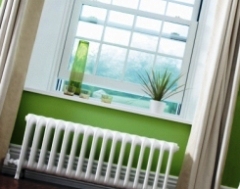Hot on the heels of their ground-breaking work to underpin the unsurpassable sustainable credentials of timber windows, the British Woodworking Federation has worked with SGS Search (Amsterdam, The Netherlands) and through the Wood Window Alliance to complete a feasibility study for a typical wooden window frame against the Materials Health elements of the stringent Cradle to Cradle Certified™ standard. The feasibility study, available to download from the WWA and BWF websites, perhaps unsurprisingly to most, demonstrates that wood is a healthy option that can easily meet the Silver level of the standard and paves the way for members to get a full products assessment and target gold or even platinum standards.
 Cradle-to-cradle is a design concept that is gaining traction around the globe. It is a holistic economic, industrial and social framework that seeks to create systems that are not only efficient but also essentially waste free. In the cradle to cradle model, all materials used in industrial or commercial processes fall into one of two categories: "technical" or "biological" nutrients. The ultimate goal is that these materials can be used over and over again instead of being "downcycled" into lesser products, ultimately becoming waste.
Cradle-to-cradle is a design concept that is gaining traction around the globe. It is a holistic economic, industrial and social framework that seeks to create systems that are not only efficient but also essentially waste free. In the cradle to cradle model, all materials used in industrial or commercial processes fall into one of two categories: "technical" or "biological" nutrients. The ultimate goal is that these materials can be used over and over again instead of being "downcycled" into lesser products, ultimately becoming waste.
Health is a critical element of the standard, recognising that many human beings come into contact or consume, directly or indirectly, many harmful materials and chemicals daily. In addition, countless other forms of plant and animal life are also exposed. C2C seeks to remove dangerous technical nutrients (synthetic materials such as mutagenic materials, heavy metals and other dangerous chemicals) from current life cycles. If the materials we come into contact with and are exposed to through their production processes on a daily basis are not toxic and do not have long term health effects, then the health of the overall system can be better maintained.
The process involves identifying the chemical composition of the materials that make up the product. Particularly hazardous materials (e.g. heavy metals, pigments, halogen compounds etc.) have to be reported whatever the concentration, and other materials reported where they exceed 100 ppm. For wood, the forest source is required. The risk for each material is assessed against criteria and eventually ranked on a scale with ‘A’ (materials of low risk), ‘B’ assessed, those chemicals with moderate risk but acceptable to continue to use, and X or banned for materials such as PVC that are identified within the standard as having high risk and would need to be phased out.
“The process was fascinating to go through and really opens the door to focussing on all elements of composition and how we make our products. We will be encouraging our members to follow ourselves and suppliers such as Teknos through the process as it also supports benchmarking and forces you to think carefully about all your decisions – really it is a natural extension of our life cycle assessment work and categorically shows that wood windows are the healthy choice,” Iain McIlwee, Chief Executive of the British Woodworking Federation said.
ENDS